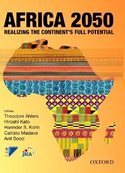AFRICA 2050 —Realizing the Continent's Full Potential—

In June 2013, JICA-RI released a report titled “Development Challenge in Africa Towards 2050” at the side event of the Fifth Tokyo International Conference on African Development (TICAD V). The report is a collaborative work between JICA-RI and the Centennial Co., Ltd. in the United States. In January 2014, a book based on this report, a compilation of the vision in various fields for Africa in 2050, was published by Oxford University Press.
For the publication, JICA-RI Director Hiroshi Kato took part as one of the editors, and Senior Research Fellow Tomonori Sudo wrote a chapter on climate change in Africa. Contributors to boxed articles include: Koji Makino, Chief Representative of JICA Ghana Office; Ryutaro Murotani, Representative of JICA Rwanda Office; Ikuo Takizawa, Director of Health division; and Kei Yoshizawa, Advisor to the Director General of the Africa Department.
The report predicts that Africa will encounter burgeoning population and accelerating urbanization towards 2050. Thus creating jobs continuously to absorb the redundant labor force will be a key factor for the stability in economic and social order. Africa’s current economic structure, counting on fossil fuels and mineral resources, are capital-intensive, which can’t expect to create many job opportunities. The transformation of economic structure in Africa will be a crucial challenge to keep sustainable growth, as well as to utilize the private sector. It is hoped that each African country will shift the economic structure to more sustainable one, while developing market and investment climate where the private sector can thrive, as well as systematically fostering human capital by enriching educational and health services.
● Contents
List of Appendixes, Boxes, Figures, and Tables
List of Abbreviations
Foreword
Preface
Acknowledgments
Introduction
Part 1: Realizing the Continent's Full Potential
Chapter 1: A 2050 Vision to Meet African Aspirations
Chapter 2: Historical Perspectives and Drivers of Future Change
Chapter 3: Action Agenda — Jobs for People, Economies, and the Continent
Chapter 4: Better Governance to Deliver Results
Part II: People, Economies, and the Continent
Section A: Prosperous People and Cohesive Societies — Jobs to Transform Lives
Chapter 5: Accelerating the Demographic Transition
Chapter 6: Eliminating Fragility and Conflict
Chapter 7: Ensuring Equity and Inclusion
Chapter 8: Breaking the Human Capital Barrier
Section B: Diverse, Competitive Economies—Private Investments to Create Jobs
Chapter 9: Maintaining Macroeconomic Stability and Increasing Resilience
Chapter 10: Enhancing Growth, Competitiveness, and Job Creation
Chapter 11: Transforming African Agriculture
Chapter 12: Harnessing Natural Resources for Diversification
Chapter 13: Managing Urbanization for Growth
Chapter 14: Enhancing Regional Cooperation and Integration on the Continent
Chapter 15: Mitigating and Adapting to Climate Change
Chapter 16: Repositioning Africa in the World
Annex 1: Commodity Terms of Trade in Africa: A Fragile Blessing
Annex 2: Model of Global Economy
References
scroll